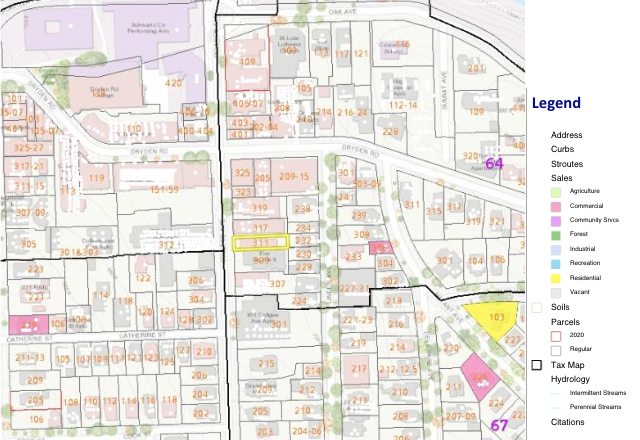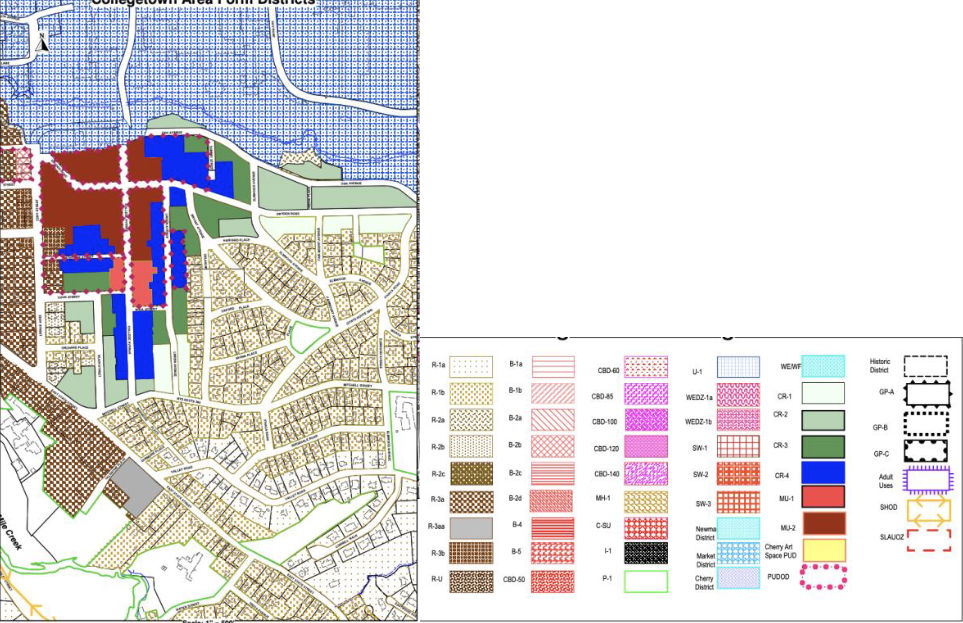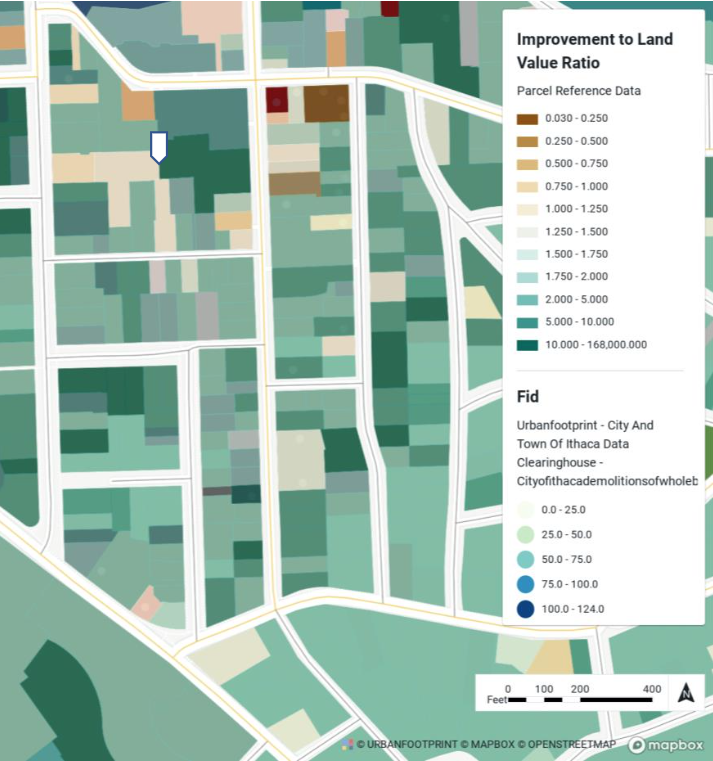311 College Ave | Ithaca, New York
Report by Lohita Turlpati
Introduction
The structure on 311 College Avenue, which was built over a century ago, has seen victory celebrations during World War I in 1918, as well as anti-war riots in 1972, when protestors attempted to burn the building down. Sitting on a narrow parcel of land between present-dayIthaca’sFire Department Station 2 and a mixed-use apartment, the building was most popular for The Nines - a popular ground level hub for scores of Cornell students for many decades.The three-story mixed-use building located close to the Collegetown Crossing bus stop has served as a firehouse, and subsequently as a bar and restaurant for over 40 years.
Location History
Because of its proximity to campus, Cornell University fostered growth in the Collegetown neighborhood, which witnessed a plethora of student housing. Many of the structures, however, were of poor quality, lacked running water, and were prone to fire. The Neriton Fire Company Number 9 was founded in Collegetown in 1895 in response to a lack of adequate and quick response to fire accidents (Crandall, 2017).
In 1895, the rear portion of the 311 College Ave. building was built out of wood. The original plan was for it to be a bell tower on the south side of Dryden Road, west of the College Avenue intersection. In 1908, the front part was added. The three-story brick and stucco structure known as The Nines was officially opened at that time(Tompkins Weekly, 2017).
In 2017, the restaurant was the topic of a controversial Ithaca Common Council debate about whether or not to designate the front portion of the building as a local landmark. The proposal was rejected, based on recommendations by a historic preservation expert (City of Ithaca, 2018). The judgment permitted the property's owners of 40 years, Mark Kielmann and Harold Schultz, to sell the land and use the proceeds to fund their retirement.
Local developers Visum Development submitted their plan for the site, which included demolishing the 1900s firehouse and replacing it with a six-story mixed-use apartment structure with 50 apartments and ground-floor stores (Crendall, 2017). Anguished by the loss of heritage value and character, the plans received much criticism from locals and was rejected during the site plan review. The Planning Board strongly advised maintaining historic components or, if required, relocating the structure. In April 2019, the building was finally sold to local developers John Novarr and Phil Proujansky, leading to a final closure of the Nines (ibid).
Zoning and Land-Use

Currently, the plot is zoned Mixed Use 2, which permits buildings of up to six stories and 80 feet in height, 70% lot coverage and 10% green space (Tompkins County; n.d.; City of Ithaca Planning and Economic Development Division; Appendix A). The property is zoned for “Urban Mixed Use” on the City’s Future Land Use Map -- containing a diverse mix of housing typologies (City of Ithaca Future Land Use Map, 2015). Marked as “TND1 High Development”, the neighborhood is envisioned along New Urbanist principles.
Since the property is in the Collegetown neighborhood, it falls within a Planned Unit Development Overlay District(PUD), “a tool intended to encourage mixed-use or unique single-use projects that require more creative and imaginative design of land development than is possible under standard zoning district regulations” (Planned Unit Development (PUD) | Ithaca, NY - Official Website, n.d.)”.PUDs allow for greater planning and design flexibility while still prioritizing public improvements, environmental sensitivity, and community character (ibid).
Parcel Context
311 College Avenue is in a neighborhood with the largest concentration of student housing in Ithaca. It was a popular student hangout, when open, because of its proximity to Green Star Food Co-op, as well as a number of notable eateries like Enzo's Pizzeria, KOKO Korean and Asian cuisine, and Starbucks. Various student housing complexes, such as Collegetown Center and 312 College Avenue stand across the street which is still lined with large, frame rental housing, many of which are approaching a hundred years. The property is on a preferred bus line and is located in a fairly dense, active neighborhood with pedestrian pathways that see a lot of foot traffic. The roadway, which is around 35 feet wide, frequently has two-side parking, making it a congested area.
Observations

The new developer owners of the property, John Novarr has also purchased several properties in close vicinity to the site. These contiguous properties are to be developed into “Catherine Commons”.Student housing, retail space, and a fitness centre are all part of this mixed-use complex.The development of Catherine Commons is part of a bigger plan to create a Collegetown Innovation District.
Even though there is no proposal yet, it is assumed that 311 College Ave will be transformed to complement the Catherine Commons develop mentor the Innovation District.The fact that the building continues to stand, unused three years after sale, does raise some curiosity as to its intended purpose.It is presumed that the property owners, will leverage the underutilization and consequent lack of profit generated from the property to build their case to tear it down. Historically, Collegetown has had some of the highest land prices per sq. ft in 1TND stands for Traditional Neighborhood Development North Eastern Unites States. Often high in demand for student housing from the wealthier class among students, the site offers a lucrative opportunity to the developers, even though it sits under utilized at this point.
Discussion

In Collegetown, the growing market niche of amenity-rich student housing indicates that decision-making has become increasingly aligned with investor interests, with an emphasis on producing higher yields and boosting shareholder value at the expense of other priorities (Appendix A). The portrayal of properties as purely financial assets to be handled in order to generate profits for investors, as in the case of 311 College Avenue and its environs, undervalues the social importance of land and property, particularly as a place for community building (Rolnik, 2013). It is also in contrast to the Goals of Land Use laid out in the vision for Ithaca’s future i.e., Plan Ithaca, Ithaca’s Comprehensive Plan.
A concerning trend is the targeting of the neighborhood's richer student population and the construction of exclusive residential enclaves with the goal of capitalizing on high-end student housing with an amenity-rich living experience (Martine et al, 2020). Student housing property’s over-commodification might have enormous social and spatial effects by denying access to low-income students, many of whom incur significant debt during their studies. The over-commodification of student housing properties could have massive social and spatial consequences by restricting access to low-income students, many of whom incur large debt during their studies. 311 College Avenue's future, as well as its ability to contribute to Collegetown's social commons, is on a knife's edge until developers make their decision.
The structure's antiquity, as well as its architectural worth as the only remaining example of turn-of-the-century municipal architecture in the 311 College Ave district, present two possibilities:
i.To preserve and reuse a portion of the building and develop around it.
ii. To demolish and redevelop, while following careful deconstruction to preserve architectural elements and building elements for reuse in newer development.
References
Tompkins Weekly. (2022). A Look Back At ... Before The Nines -Retrieved 21 May 2022, from https://www.tompkinsweekly.com/articles/a-look-back-at-before-the-nines/
City of Ithaca(2018) Ithaca Landmarks Preservation Commission (Ilpc) Notice Of Meeting & Agenda. https://www.cityofithaca.org/AgendaCenter/ViewFile/Agenda/_05082018-1618
Common Council Douses Nines Designation, Clearing Way for Development. (2018, June 7).
The Cornell Daily Sun. https://cornellsun.com/2018/06/07/common-council-douses-nines-designation-clearing-way-for-development/Crandall, B. (2017, October 20).
The Nines redevelopment project cancelled. The Ithaca Voice. http://ithacavoice.com/2017/10/nines-redevelopment-project-cancelled/
Crandall, B. (2017, September 11). Proposed Collegetown apartments could take place of The Nines after longtime run. The Ithaca Voice. http://ithacavoice.com/2017/09/apartments-proposed-nines-collegetown/
Crandall, B. (2018, December 20). Developer drops $15.6 million in massive Collegetown buy. The Ithaca Voice. http://ithacavoice.com/2018/12/developer-drops-16-million-is-massive-collegetown-buy/
Edmonds, K., Kay, D., Dotterweich, J., Ferguson, G., Hoover, C., Kerslick, G., Mohlenhoff, D., Morache, R., Pieper, A., Randall, C. J., Roberts, L., Schroeder, J.,Shelley, T., Smith, S., Wallitt, W., Erb, H., Blalock, G., Darling, M., Wilson, M., & Cornish, J. (n.d.). Comprehensive Plan Committee. 155.
Gallery: See what’s being built in Collegetown. (2018, May 2). The Ithaca Voice. http://ithacavoice.com/2018/05/gallery-see-whats-built-collegetown/
Gumprecht, B. (2006). Fraternity Row, The Student Ghetto, and the Faculty Enclave: Characteristic Residential Districts in the AmericanCollege Town. Journal of Urban History, 32(2), 231–273. https://doi.org/10.1177/0096144205281664
Nick R, Martine A (2020),Making a market for itself: The emergent financialization of student housing in Canada 2020. (n.d.). Retrieved March 14, 2022.Planned Unit Development (PUD) | Ithaca, NY -Official Website. (n.d.). Retrieved March 14, 2022, from https://www.cityofithaca.org/513/Planned-Unit-Development-PUD
Rolnik, R (2013)Late neoliberalism: The financialization of homeownership and housing rights.International Journal of Urban and Regional Research37(3):1058–1066.St, N. F. (n.d.). GUSSIMEARSYT ST JAKE ST. 1.


